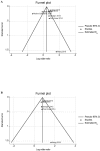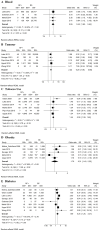Risk factors for surgical site infection (SSI) in patients undergoing hysterectomy: a systematic review and meta-analysis
- PMID: 40467315
- PMCID: PMC12142113
- DOI: 10.1136/bmjopen-2024-093072
Risk factors for surgical site infection (SSI) in patients undergoing hysterectomy: a systematic review and meta-analysis
Abstract
Objective: Surgical site infections (SSI) after hysterectomy constitute significant postoperative complications, affecting patient recovery and healthcare costs. We conducted a systematic review of risk factors for SSI in patients undergoing hysterectomy.
Design: The current study conducted a systematic review with meta-analysis to identify and summarise risk factors for SSI following hysterectomy.
Data sources: PubMed, Medline, Embase, Web of Science and Cochrane Central Register of Controlled Trials were searched through 1 November 2023.
Eligibility criteria: The inclusion criteria were (1) population: female participants who had post-hysterectomy SSI; (2) intervention: hysterectomy surgeries; (3) comparators: the number of participants who had or had not post-hysterectomy SSI; (4) outcomes: the number of participants exposed and not exposed to the risk factors of SSI. The exclusion criteria were (1) non-English studies and (2) studies that provided insufficient data.
Data extraction and synthesis: Two reviewers conducted the screening process independently. Articles that did not meet the inclusion criteria were excluded. For those that met the criteria, full-text papers were procured. Any discrepancies between the reviewers were resolved through discussion. The meta-analysis synthesised risk factors reported in ≥4 datasets via random-effects models, assessing heterogeneity, sensitivity (leave-one-out), publication bias (Egger's test/funnel plots) and subgroup analyses (incision types).
Results: Blood transfusion emerged as the largest risk factor (OR=2.55, 95% CI (1.84, 3.56)), followed by tumour presence (OR=2.23, 95% CI (1.86, 2.66)), obesity (OR=1.79, 95% CI (1.43, 2.23)), diabetes (OR=1.70, 95% CI (1.26, 2.29)) and tobacco use (OR=1.43, 95% CI (1.26, 1.63)). The ORs varied by incision type.
Conclusions: The study establishes blood transfusion, tumour presence, obesity, diabetes and tobacco use as significant risk factors for SSI after hysterectomy, with variations in risk evident across different incision types. The findings also suggest vaginal and laparoscopic hysterectomies as preferable alternatives to abdominal hysterectomy in mitigating SSI risk. Future research should aim for more granular data to untangle the interplay between comorbidities and further elucidate the differential risk across SSI types.
Keywords: Meta-Analysis; Risk Factors; Systematic Review.
© Author(s) (or their employer(s)) 2025. Re-use permitted under CC BY-NC. No commercial re-use. See rights and permissions. Published by BMJ Group.
Conflict of interest statement
Competing interests: None declared.
Figures




References
-
- OECD . OECD health data 2003. Ottawa: 2004. pp. 5–7.
Publication types
MeSH terms
LinkOut - more resources
Full Text Sources
Medical
Miscellaneous
